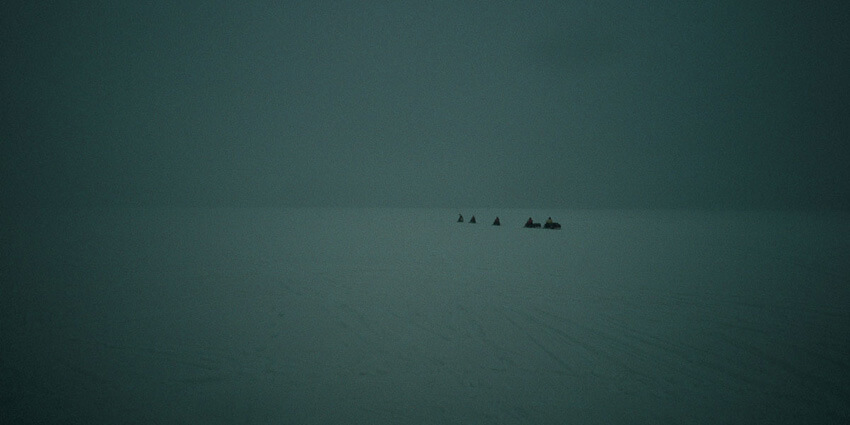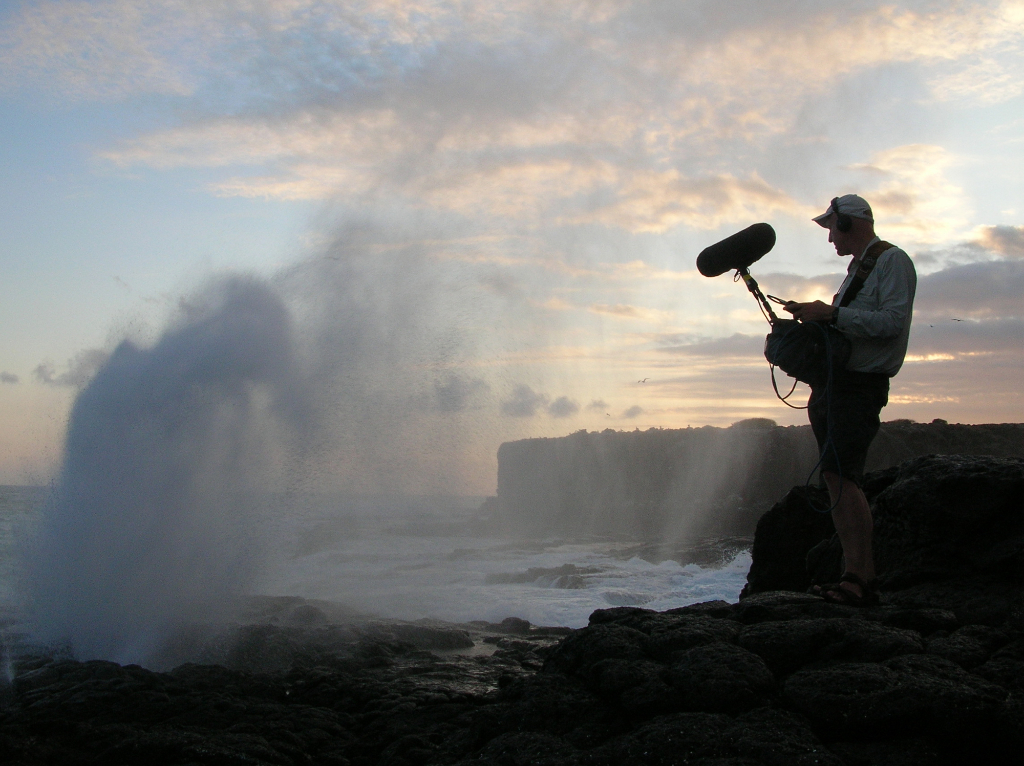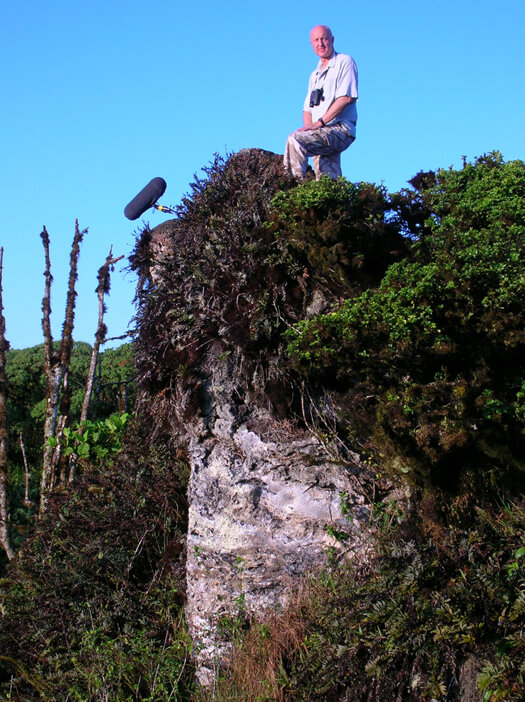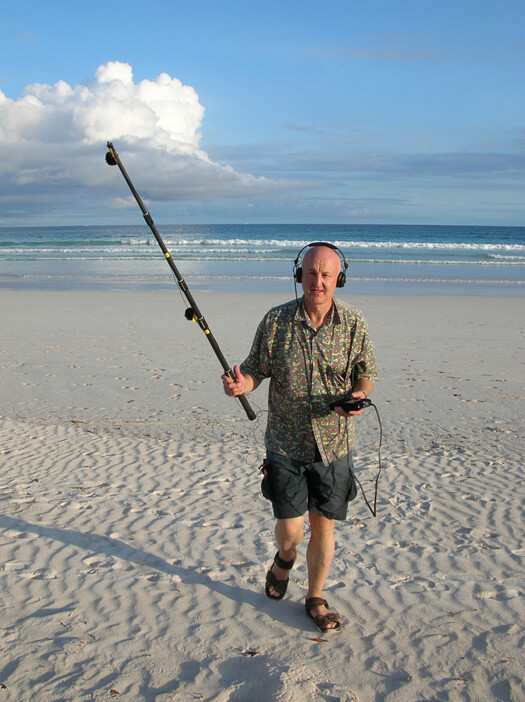Interview by Meritxell Rosell

I came across the work of Chris Watson when first introduced to his glacier recordings1. I was immediately fascinated. These peculiar sounds had obsessed me since watching an episode of the 90s TV series A Northern Exposure. Every spring, a whole Alaskan town almost goes insane because of having to hear the sounds of melting snow and glaciers for several weeks. Such a powerful and strange phenomenon.
A few years later, a random event brought me to similar thoughts: the compacted ice after a day of heavy snow melting on the terrace above the small flat in Newington Green in London I was living in at that time. We heard the squeaky, screechy and creaking sounds for days. Day after day, we kept wondering whether those noises we had never heard before were actually coming from the ice.
Chris Watson is a legend in field recordings of wildlife and natural phenomena. He grounds his work in the elusive, the hidden and the unexpected sounds coming from the natural world. He can travel to the most remote places on earth to put down his microphones and hunt for the not heard. Then, he has the magic to edit his recording into filmic narratives. He transforms them into exquisite pieces of art in doing so.
A founding member of the influential industrial Sheffield band Cabaret Voltaire, he began his sound recordist career in 1981, working for radio and in TV programs such as Attenborough’s series ‘Life’ and many other BBC radio and TV shows and series.
He has released several albums on field recordings. Some on his own, like Stepping into the Dark (Award of Distinction at the 2000 Prix Ars Electronica) and the acclaimed Weather Report. He has also released several collaborations with other artists of the calibre of Mika Vainio, Fennesz, Biosphere, and BJNilsen. He also is very prolific with installations and workshops. His latest work Okeanos is a large sound art composition that was recorded almost solely underwater. It features whales and seals chants and the clash of waves and melting ice in the water.
For many, being underwater can be an image of silence. For Chris Watson, seas and oceans are places with some of the richest spectrum of sounds. And he is here to show us.




Your work expands from sound art, field recording, and environmental sciences (ecosystems, topography…); When and how did the fascination with them come about?
It started when I was very young. I was about 12 when my parents bought me a reel-to-reel tape recorder. It was a small reel-to-reel tape recorder with a little microphone on a short cable. I explored everything in the house; the sounds of the doors, the refrigerator…I suddenly realised because it had batteries in, that I could take it outside.
That was a sort of liberating moment. We had a bird table where we lived in Sheffield, so we’d put food out for the birds. I could see the birds through the kitchen window, but obviously, I couldn’t hear them, and I felt like it was this silent film.
I went outside, which frightened all the birds off. I put some birdseed on the bird table and hung my little recorder and microphone alongside, set it going and then ran back inside. The tape only lasted about ten minutes, and then slowly, you could see them round the microphone.
Eventually, I went back out again, frightened all the birds off, and got the tape back. I like to think that I can remember that moment when I dipped into this other world, one that we really can’t normally share or experience because our behaviour would radically change what’s happening. That was the moment for me.
In his book Colliding Worlds, prof Arthur Miller remarks that both artists and scientists try to make visible the invisible. In an analogy, we could say you make audible the inaudible, coming up with sounds that most humans never get to hear. What are your aims, sound recordist, working in between technology, closer to a researcher, and art?
I still have this wonder from when I was a child of being able to hear sounds, be able to represent them, replay them and engage with them. Okeanos my latest piece, does exactly that: it makes audible sounds under the ocean that we would normally never be able to experience.
You then start to understand how rich the oceans are; it’s a sonic environment. What’s in there, how important it is and the relationships between everything that lives in the ocean and the way sound and vibrations travel.
In this piece, it’s obvious that I’m interested and concerned about the sound of the oceans, but I couldn’t do this without being enabled by technology. We are totally reliant on relatively sophisticated sound technology because what is important to me is to try and put the audience as if they were on the ocean floor, which is an impossible place for us to be. Nevertheless, this is my interpretation, and I could only do that by using this multi-channel technology.
Ordinarily, I work with people like Tony Myers, who is a professor of sound. He’s not involved in this piece, though; he normally does all the ambisonic spatialization where I have many more loudspeakers, 20-32 sometimes. You not only have planar sound, but you also have sound in a tridimensional way.
The idea is that you create what is called a sound field with a microphone in the centre of it. The aim of ambisonics is to put the audience where the microphone is, which is why I’m interested to put people on the ocean floor.
I was most fascinated with your glacier recordings, with melting/moving ice sounding otherworldly. What are the biggest challenges you faced for these particular recordings? And what has been your most challenging project?
I recorded the glaciers with hydrophones pushed into crevasses in the ice. What they’re picking up is the vibration of the glacier, so there’s much more of a physical sensation rather than just air pressure. I think that’s why it is so sort of galvanizing. It’s such a powerful sound. It physically affects us.
The challenge is representing that, which is really difficult because you need big subwoofer speakers, a big system. Moreover, it’s a very hostile environment; it can be minus 20 minus 30. It’s very much like fishing for sound; you can’t tell what something’s going to sound like, which I actually enjoy.
If I knew how it was going to sound, I’d be less interested. It’s a process of investigation and exploration, a lot of trial and error. What you don’t hear is all the recordings that didn’t work, and there are lots of them. I don’t really see them as challenges.
I see them as opportunities – but – it is a very hostile environment, so you need to be protected against the elements. It can be a dangerous place on a glacier, so there are practical considerations. My most challenging and ongoing project has been to be able to record a blue whale because of their seasonal migration, the possibility of recording only happens for two weeks a year, and they are difficult to follow
You have talked about silence and your experiences within anechoic chambers. For many being underwater can be an expression of silence, but that is quite contrary to the idea of the sound richness of the oceans you have recorded. Is it more than silence, the harmonic sound of seas and oceans that we could say induces a sense of tranquillity some people can associate with silence?
Before we’re born, we’re in a fluid. I’m sure we hear sound differently because our ears are full of fluid. After we’re born, there’s now an air gap, so even if you put your head underwater, the sound has to cross between seawater and air. It’s a very inefficient transfer – we don’t hear in the same way.
But it’s not silence. Being underwater is nothing like being in an anechoic chamber, which is a form of sensory deprivation, and I found really quite disturbing.
I was put in one by a scientist at UCL, London. They closed the door, turned the lights off, and I was on my own. I don’t think I lasted more than a minute. What I think happens is because there’s no sound unless you make a sound, our ears and brain need a reference, so our brain listens internally.
You start to hear the sound of your blood circulating, your heart thumping, and your nervous system singing. You start to hear all these weird sounds in your head, and that really freaked me out.
Silence isn’t tranquil; it’s really quite disturbing. Sound in the oceans is very rich. I find sounds in the ocean stimulating, quite scary at times, and I like it. It’s like a great piece of dramatic music with peaks and troughs. There are things that are engaging, things that are scary, things that you would move towards and some things you move away from. It’s a whole world of sound.
R. Murray Schafer devised the term “sound ecology”. Do you think sound recordists should promote a less polluted sound environment, or is this a matter of the inevitable evolution of the landscape?
From my point of view, I capture it ‘as it is’, and sometimes I represent it in that way. When it’s full of noise pollution, it’s just less interesting to me. I don’t find it engaging. I find it frustrating, and I can’t really listen to it.
Our ears and brains have evolved to be very intelligent, much more intelligent than a microphone. We are able to discriminate very quickly between background music and really concentrate on having a conversation.
Our ears and brains can do that. Microphones can’t. It’s harder to achieve that balance with a microphone than with our own ears. I don’t have this romantic view of the world I’m trying to demonstrate.
It’s just that I’ve chosen not to include all the bad recordings that have noise pollution on them; I don’t think they are interesting or engaging. It’s a piece of musical entertainment, people have to go and enjoy it, and so I’ve chosen the things that I want to hear, selfishly…
What is your chief enemy of creativity?
Noise pollution, annoyingly.
You couldn’t live without…
Apart from my family… Hearing, I listen for a living. I engage with the world through my ears, so they are absolutely crucial to me.





